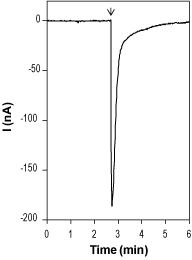Overview
- Papke, R.L. et al. (2000) J. Neurochem. 75, 204.
- Changeux, J.P. and Edelstein, S.J. (1998) Neuron 21, 959.
- Cordero-Erausquin, M. et al. (2000) Trends Pharmacol. Sci. 21, 211.
- Papke, R.L. et al. (2000) J. Neurochem. 75, 204.
- Luetje, C.W. and Patrick, J. (1991) J. Neurosci. 11, 837.
Neuronal nAChRs are a larger family of ligand-gated ion channels widely expressed in both the central and the peripheral nervous systems. At least 12 different subunits of nAChRs, including α2-α10, β2-β4, have been identified so far and these subunits form many different sub- types of nAChRs with pentameric structures consisting of homomers or heteromers1. It has been shown that nAChRs are involved in a variety of physiological functions including learning, reinforcement, development, aging and nociception2.
RJR-2403 [(E)-N-methyl-4-(3-pyridinyl)-3-butene-1-amine or metanicotine] is a potent and effective activator of human α4/β2 receptors with a significant selectivity for this receptor subtype (EC50 value = 16 μm)3. RJR-2403 exhibits potency and selectivity for CNS nAChRs thought to play a role in various CNS disorders3. Functional studies show that RJR-2403 is comparable to nicotine in activating rat thalamic synaptosomes (EC50 = 732 nM for RJR-2403 and EC50 = 591 nM for nicotine)4.
RJR 2403 oxalate (#R-115) is a highly pure, synthetic, and biologically active compound.


